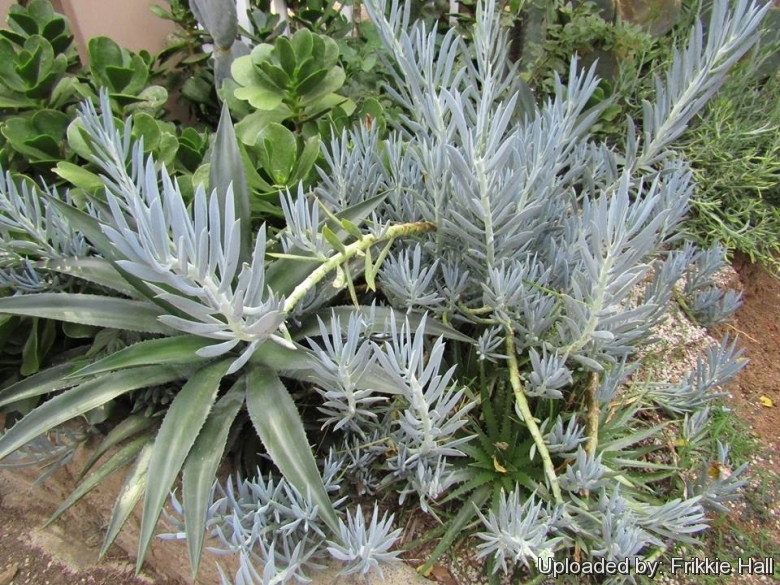Accepted Scientific Name: Senecio ficoides (L.) Sch.Bip.
Flora 28: 499. 1845

Kleinia ficoides (Senecio ficoides) Photo by: Frikkie Hall
The branches grow until they fall over and then root along the ground.
Origin and Habitat: Republic of South A frica (Northern Cape, Namaqualand, Alexander Bay). Naturalised elsewhere warm temperate to subtropical regions of the world, including Europe, Mediteranean, Asia, Australia, New Zealand and North America.
Synonyms:
See all synonyms of Senecio ficoides
back
Accepted name in llifle Database:Senecio ficoides (L.) Sch.Bip.Flora 28: 499. 1845Synonymy: 5
back
Common Names include:
ENGLISH: Blue Chalk Stick, Blue Chalk Stick Senecio, Flat-leaved Senecio, Silver Senecio, Big Blue chalk sticks
Description: Senecio ficoidesSN|32890]]SN|32890]], firstly described as Cacalia ficoidesSN|32892]]SN|32892]] by Linnaeus in 1753 , is a small evergreen, quite glabrous, pruinose succulent shrublet to 1 metre or more. It is one of the most ornamental, with strongly tapered, succulent leaves that have a grey waxy bloom on their surfaces. Small clusters of cream-coloured flower heads are borne on the branch ends. It is popular in cultivation since 1702, edible, and recently valued as a grafting stock for other succulent senecios. Senecio ficoidesSN|19303]]SN|32890]] is a very common species and local variants are commonplace, but its leaves, which are always taller than wide, distinguish it from the group around Senecio talinoidesSN|32890]]SN|19303]].
Stem: Fleshy and brittle, erect or reclining when long, branched, 8 - 12 mm in diameter, with leaf-scars below
Leaves: 8-15 cm long, 7-9 mm wide and to 15 mm thick, fleshy, erect, laterally compressed, nerveless, acuminate, powdery-glaucous and waxy with longitudinal stripes.
Inflorescences: Corymbose or subcorymbose at the summit. Peduncle elongate, many-headed. Capitula 7 or more. Involucre cylindrical. Phyllaries (scales) 7–8; Ray florets none. Disc florets 9–15, perfect, white.
Fruits (achenes): Downy.
Chromosome number: Senecio ficoidesSN|32890]]SN|32890]] is a vigorous durable decaploid (2n = 100) species.
Notes: Senecio ficoidesSN|23938]]SN|32890]] is one of the three “Blue Chalk Stick Senecios”, the other two are Senecio talinoidesSN|19303]]SN|19303]] and Senecio serpensSN|32890]]SN|23938]]. This is the largest grower of the three species and has fairly large leaves, often up to 15 cm long, narrowed on two sides and appearing more or less compressed.
Bibliography: Major references and further lectures
1) Urs Eggli “Illustrated Handbook of Succulent Plants: Dicotyledons” Springer Science & Business Media, 2002
2) Harvey, W.H. 1894. “Compositae”. In: W.H. Harvey and O.W. Sonder (eds). “Flora Capensis III (Rubiaceae to Campanulaceae)”:44-530. L. Reeve & Co., Ltd., Ashford.
3) Heath, P.V. “Three new generic names in the Asteraceae (part 2).” Calyx 6(2):54-55.1999
4) Rowley, G.D. “Succulent Compositae.” Strawberry Press, California. 1994
5) Vlok, J. and Schutte-Vlok, A.L.“Plants of the Klein Karoo.” Umdaus Press, Hatfield. 2010
6) von Staden, L. 2012. Curio ficoides (L.) P.V.Heath. National Assessment: Red List of South African Plants version 2015.1. Accessed on 2016/04/27
7) Gideon Smith, Ben-Erik Van Wyk “The Garden Succulents Primer” Timber Press, 2008
8) Royal Horticultural Society of Victoria “The Australian Garden Lover”, Volumes 52-53
page 37, Horticultural Press, 1976
Cultivation and Propagation: Senecio talinoidesSN|32890]]SN|19303]] and Senecio ficoidesSN|19303]]SN|32890]] are similar for many reasons: both succulent plants, similar in terms of morphology, they have virtually identical requirements in terms of cultivation. Them all make interesting groundcover (iceplant, basically) for xeriscaping. Hard to tell these two apart, but S. ficoides has flattened, more grey than blue-green leaves. This plant grows as a groundcover and makes a very ornamental pale blue colouring in full sun in warm climates. It's fresh new winter growth provides extraordinary form and colour contrast in the landscape when placed either with other succulents (e.g. yellow Sedum) or in a mixed planting.
Soil: It requires a very free draining enriched soil, mildly acidic to mildly alkaline but is very tolerant of poor soils.
Watering: It needs moderate water during from spring to autumn, keep rather dry in winter or the plants may rot at the base. But it adapts to different growing conditions from extreme heat and drought, to high moisture as it has a low rot potential.
Exposition: They seem to do well in part shade such as at the base of trees, but thrives also in hot sunny positions and will tolerate coastal conditions.
Frost Tolerance: It is cultivated in open air in the tropical and warm Mediterranean climate, with temperatures which it is good to keep over the 5°C, best 10-12°C, but can withstand light frost for short periods if very dry (hardy down to -2 to -10º C, even if with damage to the foliage) in these situations it will better resist if sheltered by the winter rains, seen that the humidity and low temperatures render it more sensitive to rottenness. Plants in containers however, suffered major leaf loss. USDA Zone 9b to 12.
Wind and salt tolerance: Tolerates well high wind and second line salt wind.
Maintenance: The flower stems need to be removed to keep a tidy appearance. These species do tend to get sort of leggy, which is particularly a problem if grown as a potted plant, and yearly trimming back is often necessary.
Propagation: It is easy to propagate by cuttings in late spring to summer, just take a cutting of the plant let it dry for 1 or 2 weeks and stuff it in the ground (preferably dry, loose, extremely well draining soil).










